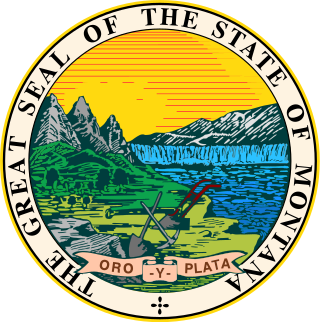Top Qs
Timeline
Chat
Perspective
Elections in Montana
From Wikipedia, the free encyclopedia
Remove ads
Montana became a territory May 28, 1864 and the first delegation created nine counties: Beaverhead, Big Horn (renamed Custer in 1877), Chouteau, Deer Lodge, Gallatin, Jefferson, Edgerton (renamed Lewis and Clark in 1867), Madison, and Missoula. Montana became a state on November 8, 1889.
This article needs additional citations for verification. (February 2022) |

Montana has a history of voters splitting their tickets and filling elected offices with individuals from both parties. Through the mid-20th century, the state had a tradition of "sending the liberals to Washington and the conservatives to Helena". Between 1988 and 2006, the pattern flipped, with voters more likely to elect conservatives to federal offices. There have also been long-term shifts in party control. From 1968 through 1988, the state was dominated by the Democratic Party, with Democratic governors for a 20-year period, and a Democratic majority of both the national congressional delegation and during many sessions of the state legislature. This pattern shifted, beginning with the 1988 election when Montana elected a Republican governor for the first time since 1964 and sent a Republican to the U.S. Senate for the first time since 1948. This shift continued with the reapportionment of the state's legislative districts that took effect in 1994, when the Republican Party took control of both chambers of the state legislature, consolidating a Republican party dominance that lasted until the 2004 reapportionment produced more swing districts and a brief period of Democratic legislative majorities in the mid-2000s.
Montana has voted for the Republican nominee in all but two presidential elections since 1952.[2] The state last supported a Democrat for president in 1992, when Bill Clinton won a plurality victory. However, since 1889 the state has voted for Democratic governors 60 percent of the time, and Republican governors 40 percent of the time. In the 2008 presidential election, Montana was considered a swing state and was ultimately won by Republican John McCain by a narrow margin of two percent.
In a 2020 study, Montana was ranked as the 21st easiest state for citizens to vote in.[3]
Remove ads
1890s
Included representatives from additional territorial counties: Meagher (1866), Dawson (1869), Silver Bow (1881), Yellowstone (1883), Fergus (1885), Park (1887), and Cascade (1887)

1892 elections
1896 elections
First election to include Flathead, Valley, Teton, Ravalli, Granite, Carbon, and Sweet Grass counties.
Remove ads
1900s

1900 elections
First election to include Broadwater County
1904 elections
1908 elections
First election to include Sanders County
1910s

1912 elections
First election to include Lincoln, Musselshell, Hill and Blaine counties.
1916 elections
First election to include Big Horn, Stillwater, Sheridan, Fallon, Toole, Richland, Mineral, Wibaux, Phillips, and Prairie counties.
1918 elections
1920s

1920 elections
First election to include Liberty, Golden Valley, and Daniels counties.
1922 elections
1924 elections
First election to include Judith Basin and Lake counties.
1928 elections
First election to include Petroleum County.
Remove ads
1930s

1932 elections
1934 elections
1936 elections
1940s
1940 elections
1942 elections
1944 elections
1946 elections
1948 elections
Remove ads
1950s
1952 elections
1954 elections
1956 elections
1958 elections
1960s
1960 elections
1964 elections
1966 elections
1968 elections
1970s
1970 elections
1972 elections
1976 elections
1978 elections
1980s
1980 elections
1982 elections
1984 elections
1988 elections
1990s
1990 elections
1992 elections
1994 elections
1996 elections
2000s
2000 elections
2002 elections
2004 elections
2006 elections
2008 elections
2010s
2010 elections
2012 elections
2014 elections
2016 elections
2018 elections
2020s
2020 elections
2022 elections
2024 elections
See also
References
External links
Wikiwand - on
Seamless Wikipedia browsing. On steroids.
Remove ads
